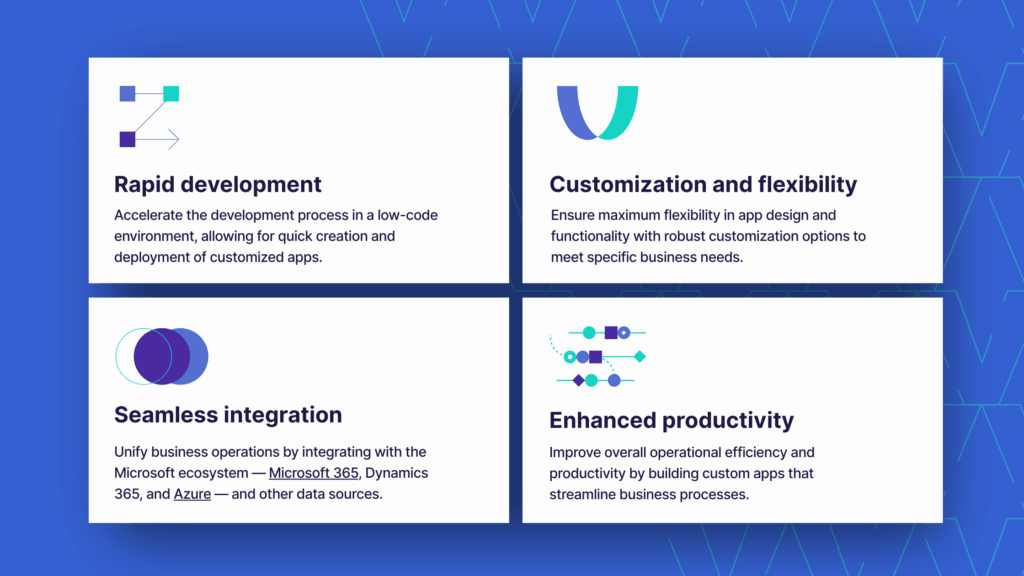Home / Blog / Insights / How to Modernize Your ERP (Without Replacing It) Using Power Apps

How to Modernize Your ERP (Without Replacing It) Using Power Apps
If your ERP system is technically doing its job but frustrating your team in the process, you’re not alone. Many businesses rely on legacy or out-of-the-box ERP platforms that are rigid, inefficient, and difficult to use, especially when it comes to day-to-day tasks like approvals, data entry, or reporting.
Replacing your ERP entirely might sound like the fix, but that kind of overhaul is often expensive, disruptive, and unnecessary. The better approach? Reimagine how your team interacts with the system, without changing the core of it.
With Microsoft Power Platform, you can build custom, user-friendly applications that sit on top of your existing ERP. These Power Apps streamline workflows, reduce manual work, and tailor the experience to your team’s needs, bringing new life to your current technology.
In this article, we’ll cover:
- The challenge with ERPs
- What is the Microsoft Power Platform?
- How it works: building a front-end app for your ERP
- Real-world examples of how this works
- Why this approach is better than a rip and replace
- Common pitfalls and how Convverge helps you avoid them
The Challenge with ERPs
Most ERP systems weren’t designed with your specific business processes in mind. They’re built to serve the broadest possible market, which often means sacrificing the type of customization your team could really benefit from. In fact, the top three places ERP systems fall short are user experience, data accuracy, and analytics.
It’s no wonder then that organizations try to remedy these common woes—but usability improvements on ERP systems lead to budget overruns a shocking 65% of the time. Even then, the question remains: is this system working for us, or is it creating more problems than it is solutions?
“The problem we run into with most ERP systems is that they’re built to fit the needs of the majority, not tailored to an individual business,” says Richard McLeod, Director of Technology at Convverge.
“Power Platform lets us flip that equation, so we can adapt the system to your workflow, instead of forcing your workflow to adapt to the system. Without that flexibility, businesses end up using band-aid solutions like Excel or email, which only create more manual work for users.”
The good news? You don’t need to rip and replace your ERP to fix these issues. You just need to rethink how people interact with it.
What Is the Microsoft Power Platform?
The Microsoft Power Platform is a suite of low-code tools that help businesses build custom solutions quickly without needing to start from scratch or rely entirely on developers. It includes:
- Power Apps – Create custom business applications with drag-and-drop simplicity
- Power Automate – Build automated workflows that reduce manual tasks
- Power BI – Turn raw data into dashboards and visual reports
- Power Pages – Build secure, data-driven external websites
- Copilot Studio – Design and deploy AI-powered chatbots that integrate with your business data
In the context of ERP modernization, Power Apps is the real game changer.
What is Power Apps? This Microsoft platform lets you build simple, intuitive front-end apps that connect directly to your existing ERP system. Whether you’re simplifying a purchase order process, digitizing approvals, or improving field service workflows, Power Apps gives you a way to tailor the experience to your business.
It’s fast to build, easy to update, and fully integrated with the Microsoft ecosystem. That means you can leverage your existing investment in Microsoft 365, Azure, or Dynamics while solving real user experience issues that traditional ERP systems often ignore.

Building a Front-End Power App for Your ERP
Power Apps gives you the ability to design a custom front-end experience—one that’s easier to use, faster to navigate, and purpose-built for how your team works. The best part is that it doesn’t require you to replace or reconfigure your ERP system.
Using pre-built connectors, APIs, or on-premises data gateways, Power Apps can securely connect to the data inside your ERP. That means you can build apps that interact with the same underlying systems, but with cleaner interfaces, mobile access, automated logic, and other intuitive workflows.
Here are some Power App examples that could be especially helpful:
- Field service operations
Technicians can use a mobile app to log service details, upload photos, and generate reports on-site without needing to log into a clunky ERP interface back at the office. - Purchase requisitions and approvals
A custom Power App can simplify multi-step approval workflows by routing requests through Power Automate and triggering real-time notifications, helping managers review and approve on the go. - Inventory management
Warehouse staff can use a barcode-enabled app to update inventory levels or track stock movement in real time, feeding directly into your ERP without extra data entry. - Customer or vendor intake forms
Instead of capturing data in email or paper forms, a Power App can standardize intake, apply logic rules (like required fields), and sync entries to your ERP system instantly. - Time entry or expense submissions
Employees can submit timesheets or expenses through a clean, mobile-friendly interface that reduces input errors and eliminates back-and-forth follow-ups from finance teams.
What This Looks Like in Practice
At Convverge, we recently partnered with a large mining company to help streamline a critical but time-consuming process: invoice approvals and posting. Their existing ERP system (SAP) handled the backend well, but the user experience was clunky and overly manual, slowing down finance workflows and frustrating staff.
Together with their internal team, we designed a custom Power App that modernized the front-end experience without touching the ERP’s core. Here’s how it worked:
- AI-Powered Data Extraction: Invoices sent to a centralized accounting inbox were automatically scanned using AI, which pulled key data like amounts, dates, vendor info, PO numbers, and invoice numbers.
- Data Validation and Comparison: The extracted information was instantly compared against SAP data to ensure everything matched up with the correct purchase orders and approval thresholds.
- Role-Based Access: Permissions were configured to give each user role the right level of visibility and control depending on where they sat in the approval or posting workflow.
- Automated Routing for Approvals: Invoices were routed to the correct approver based on cost centre via Power Automate, eliminating manual hand-offs and reducing bottlenecks.
- Automated Posting into SAP: Once approved, invoices were automatically posted into SAP—no additional entry or duplication required.
- Real-Time Status Updates: The app provided a live view of open requests and approvals in progress, improving visibility across the team.
The results were immediate and measurable:
- 70% reduction in submission time
- Approval cycles dropped from days to hours
- Significant improvement in user adoption, thanks to a cleaner, easier interface
This is the power of modernizing your ERP experience with Power Apps. You keep what works and enhance what doesn’t.

What Makes This Approach Better Than a Full ERP Replacement?
Replacing an ERP system is a major undertaking. For small and midsize businesses, the typical implementation takes three to nine months—and for larger enterprises, it can stretch to six to eighteen months. Factor in the cost, resource demands, and potential disruptions, and it’s easy to see why a full replacement isn’t always the best path forward.
Modernizing with Power Platform offers a smarter alternative.
Here’s why this approach often makes more sense:
- Lower cost, faster time to value
Building targeted Power Apps is significantly more cost-effective than a full ERP migration. You’ll start seeing impact within weeks, not months. - Retain your core systems and controls
You keep the compliance, reporting, and integrations that already work in your ERP while improving the user experience on top of it. - Tailor apps to your unique workflows
Off-the-shelf ERP systems are built for the average use case. Power Apps let you customize exactly how your business wants to work without fighting the system. - Simpler adoption and change management
Instead of retraining your entire team on a new ERP, you introduce small, intuitive apps that solve specific problems and are easier to adopt.
Challenges to Watch Out For
While Power Platform makes ERP modernization more accessible, it’s not without its challenges. Success depends on having the right foundation, oversight, and support to ensure your solution scales with the business.
Here are a few common pitfalls to keep in mind:
- Integration complexity
Connecting Power Apps to an ERP system—especially a legacy or highly customized one—can require careful planning. Data models, APIs, and access controls need to be aligned from the start. - Governance and data security
As low-code tools spread across the organization, governance is critical. You need proper controls to manage who can build, modify, and access apps and data. - Change management and user training
Even intuitive tools can fail if users don’t understand how to use them or why they should. Adoption planning, onboarding, and support are just as important as the app itself.
“When we talk about governance, anything that interfaces with ERP data is a critical-level application. That means you need proper version control, change management, and lifecycle planning. If these apps aren’t built the right way, they can expose your business to serious risks—from data leaks to long-term scalability issues,” says Richard.
That’s where Convverge comes in. Our team works alongside yours to design solutions that fit your systems and your people. From early discovery and app design to governance strategy, rollout, and training, we help ensure your modernization effort sticks.
Is ERP Modernization Keeping You Up at Night?
If your ERP is holding your team back, you don’t have to choose between living with the pain or replacing the whole system. With Microsoft Power Platform, you can modernize how your team interacts with your ERP without disrupting what already works.
Whether you’re exploring a single use case or planning a broader strategy, we’re here to help you get started the right way. Book a discovery session today to explore what’s possible with Power Apps and ERP modernization.


